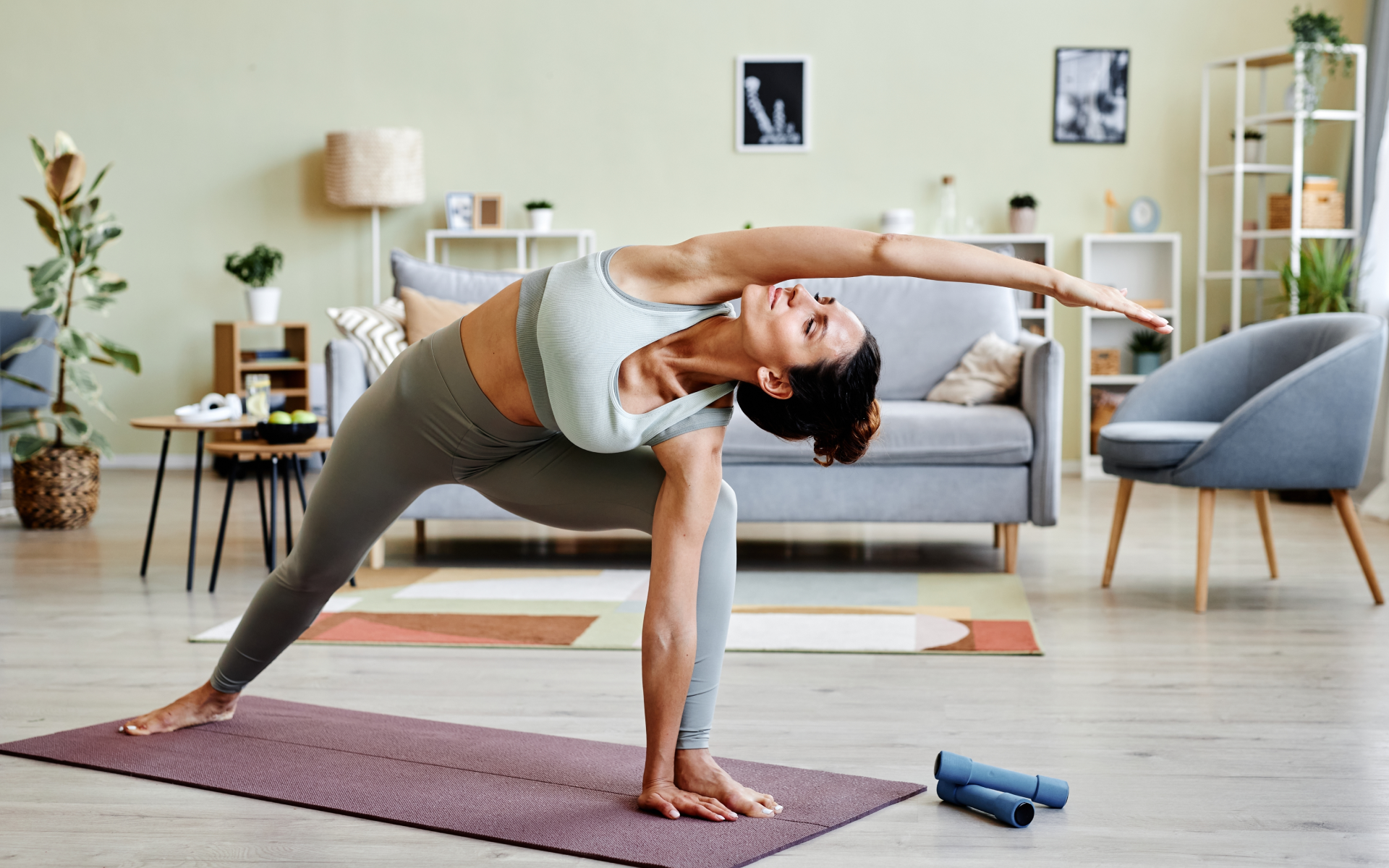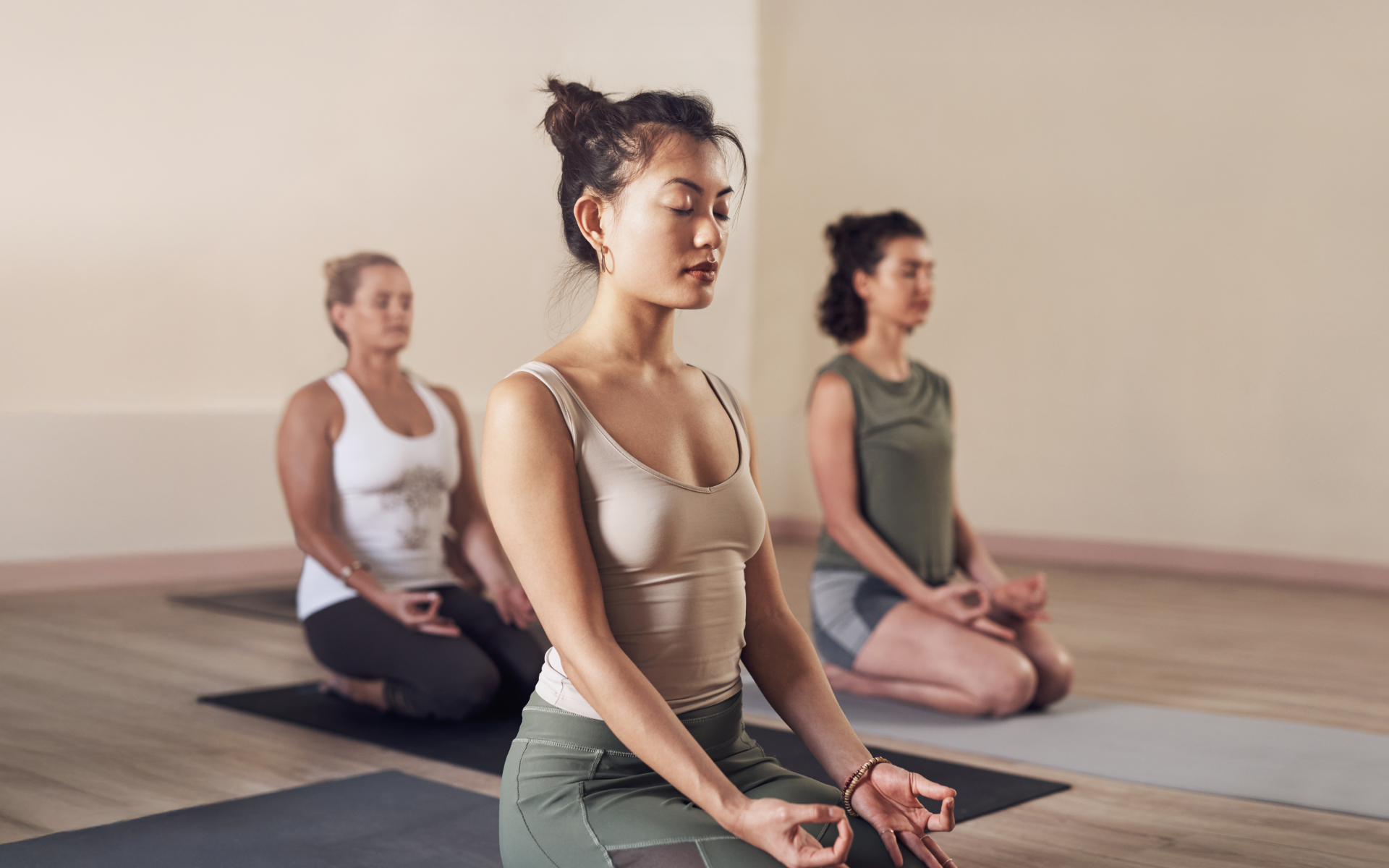Somatic exercises are all about tuning into your body and moving with mindful intention. Derived from the Greek word soma, meaning “of the body”, these exercises focus on becoming aware of your body’s sensations (1). This heightened awareness can help you identify where unresolved emotions may be physically stored, which allows for the release of tension and promotion of relaxation. The best part? Many somatic exercises can be done in the comfort of your bed. Whether you want to start your day with calmness or wind down for a restful night, these exercises offer a gentle way to reconnect with your body.
What Are the Best Somatic Exercises in Bed?
When it comes to somatic exercises in bed, simplicity is the key. Here are some of the best ones to try:
1. Pelvic Tilts
Starting Position: Lie on your back with your knees bent and your feet flat on the bed, about hip-width apart. Your arms should be relaxed at your sides.
Step 1: Start by taking a deep breath in. As you exhale, gently tilt your pelvis upward, pressing your lower back into the mattress. Focus on the sensation in your lower back and the gentle contraction of your abdominal muscles.
Step 2: Inhale slowly, allowing your pelvis to tilt downward, creating a small arch in your lower back. As you do this, feel the stretch in your lower back and the gentle opening of your hip flexors.
Step 3: Continue this slow, controlled movement, focusing on the rhythm of your breath and the sensations in your lower back and hips. Repeat this motion 10-15 times, or for as long as it feels comfortable.
Tips: Move slowly and mindfully, paying attention to how your body feels with each tilt. This exercise helps release tension in the lower back and hips while also gently engaging your core
Whether you want to learn how to exit the spiral of self-harming behavior, overcome anxiety, cure insomnia or simply give yourself the time and space to bliss out and soak up the moment of complete peace and quiet – BetterMe: Meditation & Sleep app is exactly the tool for that ! If you don’t take care of number one, who will?
2. Breath Awareness
Starting Position: Lie on your back in a comfortable position. Place one hand on your chest and the other on your abdomen. This will help you become more aware of your breathing.
Step 1: Close your eyes or maintain a soft gaze, and take a deep breath in through your nose, feeling the rise of your chest and abdomen. Notice which hand moves more – this can give you insight into whether you’re breathing more into your chest or your diaphragm.
Step 2: Exhale slowly through your mouth, feeling your chest and abdomen fall. Try to make your exhalation longer than your inhalation to help activate the parasympathetic nervous system, which promotes relaxation.
Step 3: Continue to focus on your breath, observing its natural rhythm. If your mind starts to wander, gently bring your attention back to the sensation of your breath.
Tips: This exercise can be performed for a few minutes or as long as you wish. It’s an excellent way to center yourself, reduce distress, and prepare for sleep or a calm start to your day.
3. Body Scan (2)
Starting Position: Lie comfortably on your back with your arms at your sides and legs extended. Close your eyes and take a few deep breaths to settle in.
Step 1: Start by focusing on your toes. Notice any sensations, such as warmth, coolness, tingling, or tension, without any judgment. Take a deep breath in, and as you exhale, imagine releasing any tension you feel in that area.
Step 2: Slowly move your attention up your body, from your feet to your ankles, calves, knees, thighs, hips, lower back, abdomen, chest, shoulders, arms, hands, neck, and finally, your head. At each area, pause to observe any sensations and release tension with each exhale.
Step 3: If you encounter any areas of discomfort or tension, spend a little extra time there, breathing deeply and visualizing the release of tension.
Step 4: Once you’ve scanned your entire body, take a moment to notice how you feel as a whole. You may feel more relaxed, grounded, or aware of your body.
Tips: The body scan is a powerful tool for increasing body awareness and promoting relaxation. You can use this technique to unwind before bed or as a way to check in with your body during stressful times.
Read more: Somatic Healing Techniques: A Holistic Approach to Physical and Emotional Recovery
4. Progressive Muscle Relaxation (PMR) (3)
Starting Position: Lie on your back with your arms at your sides and legs extended. Close your eyes and take a few deep breaths to relax.
Step 1: Start by focusing on your feet. Take a deep breath in, and as you do, tense the muscles in your feet as much as you comfortably can. Hold this tension for 5-10 seconds.
Step 2: As you exhale, suddenly release the tension in your feet, allowing them to relax completely. Notice the contrast between the tension and the relaxation.
Step 3: Move on to your calves, repeating the process: inhale and tense the muscles, hold for a few seconds, then exhale and release.
Step 4: Continue this pattern, moving up your body through your thighs, hips, abdomen, chest, shoulders, arms, hands, neck, and face. Tense each muscle group for 5-10 seconds, then fully relax.
Step 5: After completing the entire body, take a moment to enjoy the sensation of deep relaxation. Breathe slowly and evenly, noticing how your body feels.
Tips: This exercise is particularly useful for reducing distress, as it helps you physically release tension that may be held in different parts of your body.
Can You Do Somatic Exercises in Bed?
Absolutely! In fact, your bed can be an ideal place to practice somatic exercises, particularly if you’re looking for a gentle, supportive environment. The softness of the mattress can help cushion your joints and make the movements more comfortable.
Is It OK to Exercise on the Bed?
While somatic exercises are perfectly fine to do in bed, it’s important to note that not all exercises are suitable for a soft surface. Traditional workouts that require stability and support, such as strength training or high-impact cardio, are better suited for a firm, stable surface. However, as somatic exercises focus on slow, mindful movements, your bed is an excellent choice.
What Somatic Exercises Should I Do in Bed?
If you’re new to somatic exercises, it’s best to start with the basics that were mentioned earlier in this post. As you become more comfortable with these movements, you can gradually explore other exercises that target different areas of the body. Here are a couple of additional exercises to consider:
– Gentle Spinal Twists: Lie on your back with your knees bent. Slowly lower both knees to one side, then the other, allowing your spine to twist gently. This helps release tension in your back and hips.
– Neck Stretches: Lie on your back and slowly turn your head to one side, then the other, paying attention to any areas of tightness. This simple stretch can help relieve neck tension and improve mobility.
If you experience any discomfort or pain while doing these exercises, take a break. If the discomfort persists, it’s a good idea to consult a medical professional.
Is It Better to Do Somatic Exercises in the Morning or at Night?
There’s no one-size-fits-all answer to this. The best time to do somatic exercises depends on your personal preferences and goals.
– Morning: Doing somatic exercises in the morning can help you start the day with a sense of calm and focus, gently waking up your body and mind.
– Night: Practicing somatic exercises at night can help you unwind and prepare for a restful sleep. The gentle movements can help release the tension that has built up throughout the day, which makes it easier to relax. For example, progressive muscle relaxation is known to improve sleep quality and reduce distress (4, 5).
Ultimately, the best time is whenever feels right for you.
With stress being a constant presence in our lives, taking time to process emotions, decompress and get into the right frame of mind is absolutely crucial. With BetterMe: Meditation & Sleep app your mental health is in good hands! Start using it now !
Can You Do Somatic Exercises in Bed Every Day?
Yes, you can do somatic exercises in bed every day. As these exercises are gentle and focus on relaxation and body awareness, they’re safe to practice daily. In fact, making them a part of your daily routine can help you stay in tune with your body, reduce distress, and improve your overall mental and physical well-being.
How Can I Do Somatic Exercises in Bed by Myself?
Somatic exercises are designed to be self-guided, which makes them easy to do on your own. Start by finding a quiet, comfortable space in your bed where you can focus without distractions. Follow the steps for each exercise, moving slowly and paying close attention to how your body feels. Over time, you’ll develop a deeper understanding of your body’s needs and responses.
Read more: Somatic Dance: Liberation through Expression and Movement
What Is Somatic Work for Sleep?
Somatic work for sleep involves using somatic exercises and techniques to promote relaxation and improve sleep quality. These exercises can help release physical and emotional tension, which makes it easier to fall asleep and stay asleep. By incorporating somatic work into your bedtime routine, you can create a calming ritual that signals to your body that it’s time to wind down.
Techniques such as progressive muscle relaxation, body scans, and breath awareness are particularly effective. Research has shown that these practices can significantly improve sleep quality, helping you drift off more easily and enjoy a deeper, more restorative sleep (5, 6, 7).
How to Start Somatic Exercises
Starting somatic exercises is simple. Begin with a few basic movements, focusing on your breath and the sensations in your body. Don’t worry about getting it “right” – the goal is to move mindfully and listen to your body. As you become more familiar with the exercises, you can explore more advanced techniques and incorporate them into your daily routine.
Yes, certain belly fat exercises such as leg raises, bicycle crunches, and pelvic tilts can be done on the bed. However, for more intense workouts, a firmer surface may be better to ensure proper form and prevent injury. Focus on exercises that engage your core, such as leg raises, pelvic tilts, and gentle twists. Consistency is key, and combining these exercises with a healthy diet and overall fitness routine will contribute to seeing better results Somatic exercises such as pelvic tilts, breath awareness, and progressive muscle relaxation are excellent for relaxation and body awareness. For more active exercises, you can try gentle core workouts such as leg raises or bicycle crunches Yes, somatic exercises are effective for reducing distress, improving body awareness, and releasing tension (2, 8). While they may not burn calories like traditional workouts, they offer significant benefits for your mental and physical well-beingFAQs
Can I do belly fat exercises on bed?
How do you get a flat stomach in bed?
What exercise should I do in bed?
Do somatic workouts really work?
DISCLAIMER:
This article is intended for general informational purposes only and does not serve to address individual circumstances. It is not a substitute for professional advice or help and should not be relied on for making any kind of decision-making. Any action taken as a direct or indirect result of the information in this article is entirely at your own risk and is your sole responsibility.
BetterMe, its content staff, and its medical advisors accept no responsibility for inaccuracies, errors, misstatements, inconsistencies, or omissions and specifically disclaim any liability, loss or risk, personal, professional or otherwise, which may be incurred as a consequence, directly or indirectly, of the use and/or application of any content.
You should always seek the advice of your physician or other qualified health provider with any questions you may have regarding a medical condition or your specific situation. Never disregard professional medical advice or delay seeking it because of BetterMe content. If you suspect or think you may have a medical emergency, call your doctor.
SOURCES
- Soma- Significance: A New Notion of the Relationship Between the Physical and the Mental (1995, connectioninstitute.org)
- Differential effects of a brief body scan session on pain and anxiety levels (2024, onlinelibrary.wiley.com)
- Progressive Muscle Relaxation (2008, tandfonline.com)
- Music Assisted Progressive Muscle Relaxation, Progressive Muscle Relaxation, Music Listening, and Silence: A Comparison of Relaxation Techniques (2000, academic.oup.com)
- Effects of progressive muscle relaxation on anxiety and sleep quality in patients with COVID-19 (2020, sciencedirect.com)
- Effectiveness of Deep Breathing and Body Scan Meditation Combined with Music to Improve Sleep Quality and Quality of Life in Older Adults (2020, openpublichealthjournal.com)
- The Effectiveness of Using Breathing Exercise on Sleep Quality Among Hospitalized Patients (2020, researchgate.net)
- Immediate effects of a brief mindfulness-based body scan on patients with chronic pain (2012, link.springer.com)










